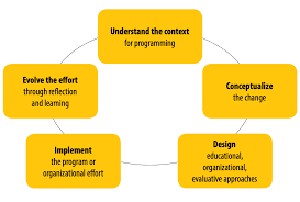Evaluation of continuing education programs refers to the systematic assessment of training initiatives in terms of both effectiveness (goal-achievement ratio) and efficiency (cost-benefit ratio). This process ensures that corporate learning and development efforts align with business goals, enhance employee performance, and offer measurable returns.
Why Evaluate Continuing Education?
Evaluation plays a critical role in:
-
Assessing impact of training on participants and the organization
-
Identifying success factors and improvement opportunities
-
Selecting appropriate training formats
-
Justifying the investment in learning and development
-
Ensuring alignment with company objectives through targeted training needs analysis
-
Reducing waste by avoiding ineffective training programs (→ see also: training controlling)
Evaluation is not a one-time check but a continuous, iterative process that begins before the training starts and continues beyond its completion.
Evaluation Throughout the Training Lifecycle
Evaluation unfolds across multiple phases:
-
Pre-Training:
-
Conducting a needs assessment
-
Setting clear learning objectives
-
-
During Training:
-
Monitoring engagement and relevance
-
Supporting practical application (e.g., project-based learning)
-
-
Post-Training:
-
Measuring transfer of learning to the workplace
-
Evaluating organizational impact and ROI
-
This comprehensive approach fosters not only quality control, but also accountability, encouraging all stakeholders (participants, managers, and trainers) to take responsibility for learning outcomes.
Challenges and Success Criteria
Measuring success in continuing education is complex due to:
-
The behavioral nature of learning outcomes
-
The many variables that influence learning effectiveness
-
The challenge of measuring long-term transfer and business impact
To truly assess a program’s success, evaluation must consider a broad range of influencing factors, both internal and external to the training environment.
Kirkpatrick’s Four-Level Evaluation Model
One of the most widely used frameworks is Kirkpatrick’s Four Levels of Evaluation (1994), which provides a structured and practical way to measure learning success:
-
Reaction: How satisfied were the participants with the training?
-
Learning: What knowledge or skills did they acquire?
-
Behavior: What learning was transferred to the job?
-
Results: What measurable benefits did the training deliver for the company?
Its simplicity, clarity, and adaptability explain its ongoing relevance in both academic and business contexts.
Final Thought
Proper evaluation of continuing education programs supports strategic workforce development, safeguards training investments, and enhances the overall learning culture of the organization. Done right, it transforms training from a cost center into a driver of measurable business value.
« Back to Glossary Index






